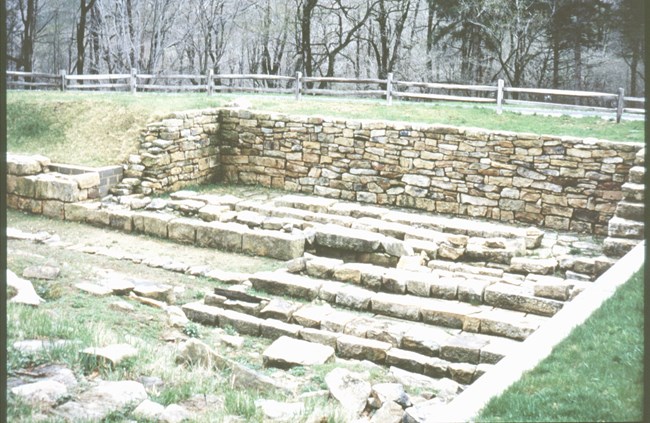
NPS OverviewThe Allegheny Portage Railroad scaled the 1,400-foot elevation of the Allegheny Mountains in west central Pennsylvania. Built as part of Pennsylvania's canal system, the Allegheny Portage Railroad allowed passengers and goods to be moved between Johnstown and Hollidaysburg while on their way from Pittsburgh to Philadelphia. Completed in 1834, the Allegheny Portage Railroad boasted four massive stone viaducts, more than 72 stone culverts, the first railroad tunnel in the country, 10 stationary steam powered engine houses, and 36.65 miles of railway. OperationThe Portage consisted of 11 relatively level horizontal passages that were linked by 10 'steep' inclined planes. The inclines were generally 0.5 mile in length, while the levels ranged from 0.15 mile to 14 miles. The gradient on the inclines could, by law, be no greater than 12%. The steepest of the inclines was Incline 8 at 9.9% Railroad cars, or sometimes sectional canal boats, were pulled up or lowered down the inclines by stationary steam engines (30 to 35 horsepower), using a hemp rope approximately 7 inches in circumference. This rope was later replaced with wire cable. The ascending or descending cars were counterbalanced with other cars when possible. The stationary steam engines that drove the hoist mechanisms were at the top of the inclines; hitching sheds at the bottom. Contents of the Engine HousesAt the head of each incline was an engine house built of wood. It contained the stationary steam engine, wheels, gears, hydraulic pistons, vertical 8-foot wheels, horizontal 9-foot by 7-inch sheaves, and wells approximately 3 feet wide and 8 feet deep. The cast iron wheels or sheaves that drove the hoist mechanism were placed beneath the railway system. The use of these mechanical features helped make the most efficient use of power and reduced the strain on the steam engines. The well accommodated suspending weights and connecting chains that allowed the carriage to be drawn backward and forward. No drawings or specifications for structures along the Allegheny Portage Railroad have been found despite repeated investigations. Engine House No. 6On April 1, 1833, James Stackpole, William Woodburn, and H. Simsonton won a contract to build "An Engine House and Road Shed at the Head of the Plane [incline 6], and a Road Shed at the foot of the plane together with all the Masonry Excavation & Connected with the Same." The engine house at the head of incline 6 was completed by May 30, 1834. On the morning of May 4, 1852, a boiler explosion at Plane No. 6 took the lives of three workers and made replacement of the north boiler and engine foundation mandatory. One piece of the boiler weighing 500 lbs. was thrown a distance of 100 feet down the plane. Owen Reilly & Mathew Purcell were severely scalded and died the afternoon of the accident. Felix Handlin died of scalds and injuries later that night. Abraham Westfall was injured on the hand. According to the Ebensburg Mountain Sentinel of 5/6/1852, “This sad accident casts a gloom over the community, and we can scarcely realize the fact that those industrious men, respected for their good qualities by all, have so suddenly been cut off in the midst of a life of labor and usefulness and taken from our midst. But so it is. The piercing sorrows which pervade the hearts of relations is shared in by hosts of friends.” It was said that the boiler was in a worn-out condition and had been leaking that morning. The other stationary engine at the plane was unharmed and trains passed as usual that evening. This accident cost $3,780.00 to repair. Engine House No. 6 Exhibit ShelterThe stationary steam engine and gears exhibit in Engine House No. 6 were designed and produced by park volunteer Fred Connacher. He made many of the other models on display in the visitor center as well. A local history buff, Mr. Connacher did the research and study to design the exhibits as accurately as possible and built them as if they could be turned on and used immediately. |
Last updated: April 5, 2024
